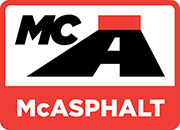Open Graded Mixes
“The right treatment, to the right road, at the right time.”
An open graded cold mix is a coarse aggregate mix (very small amount of fine aggregate) with a large amount of air voids to allow for water to drain. These mixes can be used as a base or surface course and show excellent resistance to fatigue, reflection cracking, rutting, and shoving. Open graded mixes are useful for restoration or new construction at varying depths, either mixed in place or stockpiled.
Design Criteria
When designing an open graded cold mix, a number of factors have to be examined and assessed to ensure a high-quality pavement surface: aggregate shape, specific gravity of the aggregate, aggregate type, and residual asphalt content.
Aggregate Shape and Type:
The overall shape of the aggregate used in an open graded cold mix can influence the quantity of aggregate and asphalt emulsion required for an effective mix. With larger aggregate sizes, less emulsion is needed and vice versa. The gradation of the aggregate can also influence the quantity of both the aggregate and the emulsion required.
Specific Gravity of Mix Aggregate:
The bulk specific gravity of the mix aggregate will affect the quantity of aggregate required to make an effective product. Aggregate with a higher specific gravity requires a higher volume of aggregate and vice versa.
Asphalt Residual in the Emulsion:
The quantity of asphalt residue in the emulsion used in an open graded cold mix will affect the quantity of emulsion needed to hold the aggregate skeleton/mixture together. With a lower asphalt residue, more asphalt emulsion is required to achieve the desired effect. Also, the more viscous the emulsion is, the better the mix should perform because open graded cold mixes require a thick film of asphalt in order to provide greater durability. Higher viscosity emulsions result in less draindown prior to the curing of the emulsion-based mix and allow for the thicker needed films.
There are basically two key tests that need to be performed when designing an open graded mix; emulsion/aggregate compatibility and runoff test. The emulsion being used has to be compatible with the aggregate to ensure that a good bond will develop between the residual asphalt and the coarse aggregate. The runoff test determines the optimal emulsion content required to give the mix sufficient workability, film thickness and aggregate-coating properties.
There are two key tests that need to be performed when designing an open graded cold mix: emulsion/aggregate compatibility and runoff. The emulsion being used must be compatible with the aggregate to ensure that a good bond will develop between the residual asphalt and the coarse aggregate. The runoff test determines the ideal emulsion content required to give the mix sufficient workability, film thickness and aggregate-coating properties. An open graded cold mix would typically require an emulsion content of 5.0 to 7.0%
Materials
Asphalt Emulsions:
A medium-setting emulsion containing a small quantity of solvent is used in open graded cold mixes. The use of solvent provides the mix with flexibility and helps the mixture flow evenly through the paver screed. The type and grade of emulsion to be used is based on a number of factors: environmental conditions (temperature and humidity), the type and volume of traffic, the type of blotter sand and the existing road surface’s physical characteristics such as slopes, shade, hills, and curves. Typically, the most common emulsions used are CMS-2, CMS-2h, MS-2, and MS-2h, as well as proprietary emulsions. Alternatively, gelled and fluxed asphalts can be used for open graded cold mixes.
Cold Mix Aggregate:
The type of mix aggregate used in open graded mixes must meet certain requirements of shape, size, gradation, cleanliness and surface properties. The aggregate should have a maximum size of 25.0 mm for base courses, 12.5 mm for surface courses and have between 0 and 10% passing the 4.75 mm sieve size with no more than 2% passing the 75 micron sieve size. The number of flat and elongated particles should be kept to a minimum so that the proper quantity of asphalt emulsion can be applied to hold the aggregate in place and to minimize the bridging effect between the particles. The % crushed faces of the aggregates should be a minimum of 65% two faces and 90% one faced. Also the asphalt emulsion to be used and the coarse aggregate must be compatible to ensure the asphalt-aggregate bond is effective.
Performance Guidelines
In order to construct a well-designed, high-quality open graded cold mix, the following guidelines should be followed:In order to construct a proper well designed open graded mix the following guidelines should be followed:
- Ensure the existing pavement structure is adequate for supporting the expected traffic
- Design an open graded cold mix with the aggregate to be used on the job
- Use a clean and hard crushed coarse aggregate with a very low fines content
- Ensure that the asphalt emulsion and aggregate to be used are compatible
- Ensure that an adequate amount of emulsion is used
- Ensure that the aggregate is moist but not saturated. This will reduce surface tension between the emulsion and the stone to promote uniform coatings and proper adhesion
- Calibrate and inspect all equipment
- Use a sufficient number of properly weighted steel rollers in static mode
- The use of blotter or choke sand is recommended to prevent pick-up
- Correctly execute all required construction techniques
- Use traffic control to protect the mix
- Work only in weather suitable for the type and grade of emulsion being used
